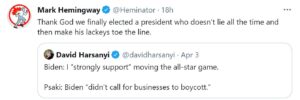In his book “Land of Hope: An Invitation to the Great American Story,” Wilfred McClay says, “For the human animal, meaning is not a luxury; it is a necessity. Without it, we perish. Historical consciousness is to civilized society what memory is to individual identity.”
Political activists are working to control the historical consciousness of students in California. State legislators are pushing to make courses in ethnic studies as universal an experience as P.E. and math, and proponents of critical race theory are shaping the new curriculum into a tool to indoctrinate students with blatantly Marxist ideology.
Districts are implementing these “ethnic studies,” so families have an opportunity to urge local school boards to provide education instead of indoctrination. Ultimately, whether or not parents can stand successfully against local radicals, they must know the truth about what their children are learning.
Ethnic Studies: The New Core Subject
Last year, lawmakers voted to force the California State University system to require all students to take ethnic studies. The legislature is expected to also make high school diplomas contingent on the subject as well.
Although he recently vetoed a similar bill, the governor implied he will sign a mandate once the state’s model ethnic studies curriculum is completed. The third draft of this curriculum was recently approved by the Board of Education. Significantly, this model repeatedly offers advice for implementing ethnic studies in “Kindergarten through 12th Grade.” This isn’t just a college class anymore.
Nor is it necessarily just one class. The District Implementation Guidance from the State Ethnic Studies Model Curriculum calls for ethnic studies to “Engage a range of disciplines beyond traditional history and social sciences, including but not limited to: visual and performing arts, English language arts, economics, biology, gender and sexuality studies, etc.” It also suggests expanding an initial pilot class into “a full-year course or even a set of courses,” or taking an existing course for a different subject and teaching it “using an ethnic studies lens.”
Parents curious about how an “existing course” might be taught through an “ethnic studies lens” should read about the “ethno-mathematics” classes in Seattle, in which students in math class were asked to interpret the subject through the themes of power, oppression, resistance, and liberation so that math could be rehumanized and freed from Western appropriation.
Promises of ‘Critical Thinking’ and ‘Empowerment’
Fans of ethnic studies promise it will teach communication skills, critical thinking, and civic involvement. Above all, the most frequent argument is that minority students need to learn about their heritage to become engaged and empowered. As advocates of ethnic studies say, “No history, no self.”
It’s a valid argument — humans do need an identity informed by history, heritage, and culture. Furthermore, all students of course should learn about people who are different from themselves.
Supporters also point to increased student engagement. This is no surprise — the way ethnic studies classes are usually taught is engaging. These classes provide students a cohesive moral framework and invite them to use it. By grappling with questions of right and wrong, justice and injustice, ethnic studies centers on stories that remind students that good and evil are real. No wonder students may be interested!
Unfortunately, critical race theorists are using the positive side of ethnic studies to claim ownership of what it means to be a minority. The cohesive moral framework they offer forces all users into predetermined conclusions. Critical race theorists do not intend to mold citizens who value true diversity — they want activists who will agitate for a narrow political vision.
Heavily Shaped by Critical Race Theory
When Los Alamitos Unified School District Board of Education voted recently to create an ethnic studies course, Board Vice President Diana Hill was quoted by a local outlet as saying, “I think that there’s a fear out there that we want to indoctrinate our students, and I do not believe that with any part of my heart.”
Unfortunately, despite Hill’s good feelings, indoctrination is a genuine concern. I hope she and other school board members will not follow the lead of the State Model Curriculum without giving serious thought to its overwhelming ideological slant. The introduction to the Model Curriculum says, “The foundational values of ethnic studies are housed in the conceptual model of the ‘double helix’ which interweaves holistic humanization and critical consciousness.” These values will allow students to “critique empire-building in history and its relationship to white supremacy, racism and other forms of power and oppression.”
The footnote gives examples of the kind of oppressions the writers have in mind:
… Such as, but not limited to, patriarchy, cisheteropatriarchy, exploitative economic systems, ableism, ageism, anthropocentrism, xenophobia, misogyny, antisemitism, anti-blackness, anti-indigeneity, Islamophobia, and transphobia.
Thus armed, the document says, students can “conceptualize, imagine, and build new possibilities for a post-racist, post-systemic racism society that promotes collective narratives of transformative resistance, critical hope, and radical healing.”
Parents need to understand that behind the waterfall of vocabulary is a militant ideology. When kids are taught to subject all of life to “critical consciousness” in order to find the “oppressor” and the “oppressed” everywhere and at all times, they are taught that the only ultimate meaning in life is power.
Furthermore, since power is always oppressive in this thought system, all social structures — including families, churches, and our constitutional republic — must be deconstructed. Worse, critical race theorists want students to accept the assumption that anyone who fails to swallow these rules wholeheartedly is a tool of oppression. Ultimately, it’s a highly effective way of preventing dialogue and pitting students against students.
Indeed, Karl Marx would have found all of this quite familiar. Writer Yoram Hazony notes Marx, too, taught his followers to divide the world into the two categories of the oppressed and the oppressors.
Furthermore, according to Marx, just as members of the dominant class do not realize that everything they do oppresses the disenfranchised class, so also most members of the disenfranchised class do not realize they are being oppressed — everyone needs to be awakened to the truth. In the end, the oppressed must overthrow the existing society to usher in utopia.
The similarities between critical theory and Marxism are bad news for California and even worse for America, as Marxism has a track record of making the world a poorer place in every sense of the word.
Erasing Those Who Don’t Fit the Marxist Narrative
Despite community campaigns by groups such as Koreans, Arabs, Jews, and Armenians to broaden the focus of the ethnic studies program in California, the Model Curriculum writers have resisted what they call “watering down” the traditional focus on African Americans, Native Americans, Latinos, and Asian Americans. In defiance of California’s actual ethnic diversity, the Model Curriculum largely relegates other ethnic groups to an appendix. Is this, perhaps, because critical race theorists are resistant to allowing students to focus on ethnic groups who do not fit neatly within the critical race narrative of systemic racism and white oppression?
Similarly, the Model Curriculum smears or erases a variety of actual minority heroes who defy critical race categories. Martin Luther King Jr. is treated as a passive racial “accommodationist” who should — at best — be ignored. Furthermore, instead of listing inspiring minority figures like Katherine Johnson of NASA or the Navajo “code talkers,” the Model Curriculum invites students to admire figures like Yuri Kochiyama, who has openly expressed admiration for al-Qaida, Osama bin Ladin, and Assata Shakur, a bank robber convicted of first-degree murder for killing a police officer.
Proponents of ethnic studies frequently claim that without their subject, minority students will not learn about people who look like themselves. The claim is disingenuous. What these activists want is not to give students a thorough, balanced knowledge of minority history and culture in America. They want to teach students — particularly minority students–to define themselves through a specific ideological lens.
Lia Rensin is a parent in the Santa Clara School District and a member of The Alliance for Constructive Ethnic Studies. She points out that one problem with critical ethnic studies is the way it takes Californian kids from a hugely complex diversity of background and “puts them in a box, then puts a label on the box.”
This “woke-washing” of history isn’t the only way the Model Curriculum exerts ideological pressure. It provides a radical set of instructions designed to squeeze ideological compliance out of teachers.
Encouraging Communist-Style ‘Self-Criticism’
The Model Curriculum’s instructional guidance calls ethnic studies a tool for “liberation.” Teachers, therefore, will need to unpack and repent of their privilege:
… teachers who may feel especially concerned with teaching ethnic studies should work through assignments like critical autobiography, critical storytelling, critical life history, or keeping a subjectivity journal, to begin the process of “constructively situating oneself in relationship to ethnic studies.”
In other words, teachers must be taught to view critical race theory as true and their own beliefs as subjective products of experience and privilege. Those who resist can be punished by being told to offer up the self-flagellation of critical self-examination.
The process sounds more like a tactic in an ideological war than a way to genuinely empower teachers. Indeed, it’s uncomfortably reminiscent of the public “self-criticism” sessions that were routinely used to destabilize communities and to punish individuals during the Cultural Revolution in China.
Choosing to Follow the State Model?
Local districts have the freedom to decide how closely to follow the state model. They will be under pressure from activists who complain that even the relatively radical State Model Curriculum has been “whitewashed” and weakened.
One of the original drafters, for instance, accuses the state of giving in to “white supremacist” organizations such as the Hoover Institute and the Jewish Anti-Defamation League for allowing edits on the first, even more biased draft. Another writes angrily that “a critique of capitalism” is “central to a decolonial pedagogy” and that failing to specifically call out capitalism fails the entire purpose of ethnic studies.
These radical voices shouldn’t be the only ones talking. Other alternatives do exist. The Alliance for Constructive Ethnic Studies recommends the more-balanced approach taken by the Los Angeles Unified School District. It’s notable that the sanest passages in the State Model Curriculum — such those referencing the need to allow students freedom of thought rather than pressuring them to come to any particular political conclusions — are cited as the work of LAUSD. Local schools can be encouraged to draw from this example.
The field of ethnic studies is poised to shape how students across California understand their own identity. It’s an enormous project, and one with the potential to change our nation forever.






